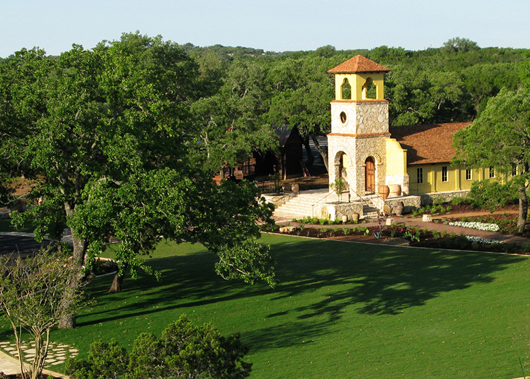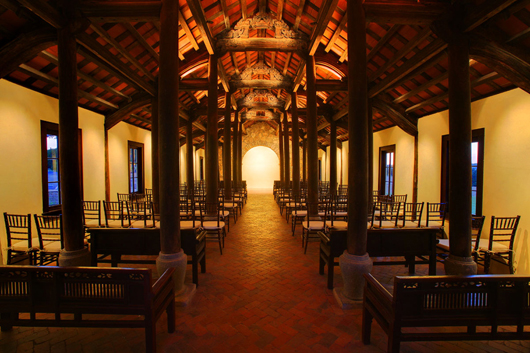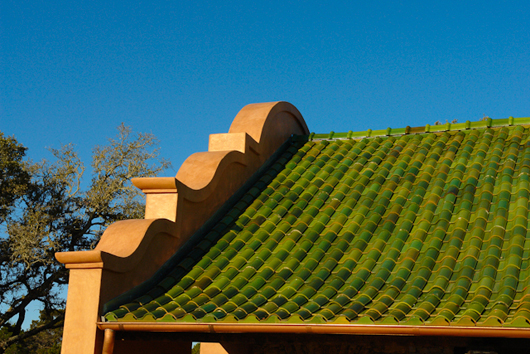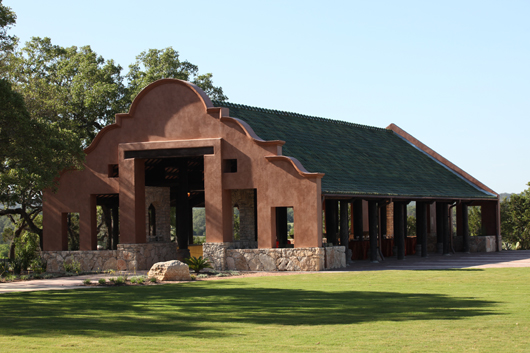
The churches, which were disassembled and shipped to Hanks in carefully numbered pieces, were re-erected on his 300-acre country property in Dripping Springs, Texas, known as “Camp Lucy.” Nestled in the state’s picturesque Hill Country, Camp Lucy – with its restored French Colonial chapel and dramatic open pavilion made of ironwood timbers – is a one-of-a-king venue for weddings and other special events.
How the restored churches ended up in Texas is a tale as colorful as the sweeping panorama they now survey.
The Camp Lucy story started in 2007. Hanks had developed an interest in Vietnamese antiques after visiting Hanoi with his son, Ian. Hanks had the opportunity to buy the entire contents of one store for $55,000 and took it. When the shipment arrived, he found a lot of saint statues and other religious icons.
“Where did these come from?” he asked his Vietnamese deal-broker, Hung Lai Manh.
“When we buy the church, we get the saints,” he was told.
Hanks learned that a lot of churches built in the 1800s were being torn down in Vietnam, where Catholicism was enjoying a resurgence and congregations were eager to build new, bigger churches.
“I said, ‘Heck with the saints; I want the church,’” he said.
Hung found one for sale. Hanks insisted on traveling to a remote village in Vietnam to see it himself. Big mistake: The price for the obviously well-to-do American who arrived by private car escalated from $55,000 to $80,000, then $110,000. Hanks scrapped that deal and started looking at pictures of churches sent to him by Hung.
“I wound up with this church,” he said, sitting in the sanctuary of the main Camp Lucy chapel, “which I really bought as a pig in a poke.”
The church had already been disassembled. Hanks had to buy it in a convoluted way, because Vietnamese law dictated that a church could only be sold to another congregation. He got a congregation to essentially act as a broker and, for a fee, resell him the church.
“I paid $40,000 for it,” he said. Shipping and reassembling brought the total cost to $125,000.
The church’s hefty, dark support columns and rafter beams are ironwood.
“Ironwood is three times as heavy as oak,” Hanks says. “It’s insect-proof because it’s so dense. You can’t pound a nail into it. We had to pre-drill the nail holes.”
Yet, the rafters are ornately carved with pastoral scenes and Chinese characters. Hanks says the church dates to the 1880s, but some of the carving was probably done later.
The wood in the church is original. Each piece was carefully numbered when the church was disassembled so that it could be reconstructed. The terra cotta roof tiles are from Vietnam, but new; the originals shattered when the church was disassembled.
Hanks had the altar and back walls constructed from limestone on his property, with little cubbyholes where some of the Vietnamese saints are placed. The side walls are plaster, and the floor is made of brick pavers from San Antonio. The result is a cocoon-like, intimate chapel.
Outside, Austin landscape architect Paul Smith used deer-proof, drought-resistant plants, including cactuses, to create a pastoral garden, interspersed with antique art including a Cambodian forest fairy statue and an antique faux bois (concrete masquerading as wood) bird cage.
Then there’s the pavilion, for which Hanks acquired a second church. Its ironwood columns are even bigger and heavier than the first church’s.
“Each one of those weighs about 2,000 pounds,” he says. “It took a forklift to position them.”
The pavilion’s roof of green-glazed tile was salvaged from the Bexar County Courthouse when it got a new roof. The pavilion was erected without walls and flows into an outdoor celebration area with a little alcove overlooking the hills.
Off to the side is a limestone building that includes a catering kitchen and a groom’s quarters. The bride’s cottage is on the other end of the grounds, next to the chapel.
“That’s my gesture to my wife,” Hanks said.
The little house is constructed and designed in the style of an English cottage in homage to Cornwall, England, Alison Hanks’ favorite vacation destination.
Anyone who might be tempted to compare Hanks’ church-revitalization project to an oddball gimmick like the relocation of London Bridge to Lake Havasu, Arizona, should think again. Hanks’ motivation for rescuing priceless architectural treasures of French colonial Vietnam is only the latest chapter in his long and distinguished history as an antiquarian and preservationist.
Hanks’ passion for antiques was sparked more than 30 years ago when he inherited his grandfather’s New York apartment, which was stylishly decorated with fine antique furnishings. The luxe antiques lit a fire within Hanks, who set out to find a way to incorporate distinctive architectural antiques into his newly built structures. The real estate developer and antiques maven-in-training was soon off to Europe in search of architectural salvage.
Over the next 10 years, Hanks made dozens of trips to Britain, Belgium, France, Spain, Austria, and Hungary. The transatlantic journeys evolved into more than just salvage-gathering excursions. With an eye for design and an unquenchable desire for antiques knowledge, Hanks went on to amass the mind-boggling collection of antiques that spurred his conversion of Austin’s original Coca-Cola bottling plant to Whit Hanks Antiques, a center for his collections and those of other antiques dealers.
In 2007, when Whit’s son Ian moved to Asia, the antiques-buying odyssey began that Hanks describes as “East meets West” – the fitting title for the auction of his antiques to be conducted on June 26-27 at Austin Auction Gallery. The sale will feature fine art and antiques from not only the Hanks collection but also other Texas estates. Internet live bidding will be provided exclusively by LiveAuctioneers.com.
Watch for a full preview of the sale to appear soon on AuctionCentralNews.com. Additional information is available at www.austinauction.com. Contact Chris or Ross Featherson at Austin Auction Gallery by calling 512-258-5479.
Copyright 2010 Associated Press and Auction Central News International. All rights reserved. This material may not be published, broadcast, rewritten, or redistributed.
ADDITIONAL IMAGES OF NOTE
.jpg)





